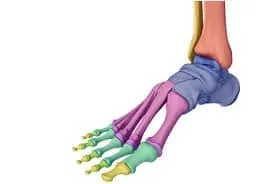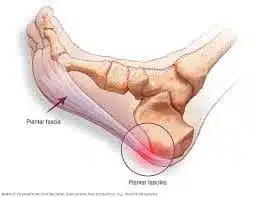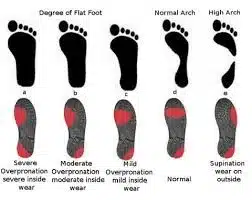Statistics estimate the average person will walk anywhere from 100,000 to over 200,000 miles in their lifetime. These astounding figures should tell us that we owe a lot of our ability to move around and engage in physical activity, to the work performed by our humble feet. When a person takes care to wear proper supportive footwear, they can accomplish some amazing feats of physical performance. Conversely, without proper footwear, a person’s feet and/or ankles become much more prone to injury. Of course, many injuries can be avoided simply by wearing the right footwear when engaging in physical activity. Here’s what you need to know about finding the best footwear for your foot pain or ankle pain.
Foot and Ankle Anatomy
The necessity of good footwear actually begins with describing the anatomical components of the feet and ankle areas. The toes make up the topmost portion of the foot. Toes play an essential role in maintaining good balance during movement. They also play a substantial role in supporting the weight of a person’s body as a person reaches the end of a single step and begins to take another. The sole of the foot is the area underneath the foot that extends from the bottom of the toes all the way to the heel. The sole plays a major role in bearing a person’s body weight. It must also be flexible enough to handle all the twists and turn movements found in physical activity.

The arch component of the sole plays a critical role in absorbing much of the shock that occurs during activities such as walking or running, through a network of tough ligaments (plantar fascia) and tendons attached to the tarsal and metatarsal bones of the foot. The last component of the foot, the heel, contains the largest bone throughout the entire foot region. When a person takes a step, their heel is the first part of the foot to strike the ground, thus experiencing most of the initial impact of every single step.
Last but not least, is the ankle region. The ankle connects the foot to the leg, of course, however, it also contains multiple joints that play a crucial role in allowing the foot to maneuver into a variety of positions, including up and down and left and right.
The Anatomy of Good Footwear
Understanding the various components of the foot and ankle region and how they all work together, allows a person to then understand why footwear should support the toe region (toe box), the sole of the foot, the arch and heel areas, and both ankles as well. Wearing footwear that does not provide the proper space and support means a person becomes more susceptible to foot issues such as heel pain, inflammation of the plantar fascia (plantar fasciitis), arch problems, and/or toe issues such as blisters, bunions, etc.

Wearing good footwear means wearing shoes that are neither too small or too large. There should be a 1/2″ space between the top of the toes (whichever one is tallest) and the top of the shoe. The toe box should allow at least 1/4″ on both the inside and outside areas of the toes. To determine whether the sole of a shoe is supportive, try twisting it back and forth as if wringing out a wet towel. The more difficult it is to perform the motion, the more sole support the shoe possesses.
It’s also important to evaluate how the shoes fit and feel during physical activity. Walk around the store for a few minutes, jog a few steps in place if you are looking for running shoes, and do some quick starts and stops if you are looking for shoes to wear for tennis or basketball. Lastly, look in a mirror from the front, the side, and the rear, to assess if the shoes provide proper ankle alignment.

How Physical Therapy Can Help
If you’ve tried selecting footwear for foot pain on your own without success, you may have a foot problem* such as fallen arches (flat feet) or an excessive arch. People with flat feet are more susceptible to overpronation, which is a condition where the ankle(s) collapse inward. Those with an excessive arch often experience problems with over supination, where their ankle and feet bow outwardly giving the impression they are almost walking on the side of their foot.
A professional physical therapist can help diagnose foot issues and assist in correcting foot problems by recommending stretching and strengthening exercises to combat weaknesses, along with providing expertise on how to select the right footwear. If you or someone you know experiences repeated foot problems during physical activity, we can help. Please contact us at 385-888-7890 or email us at: brandon@rockrunpt.com.



